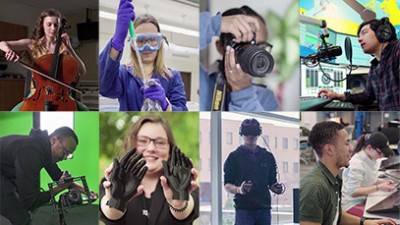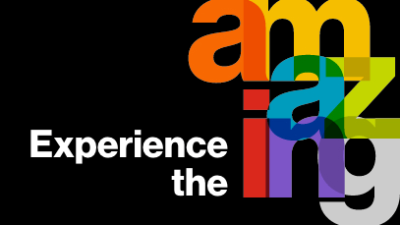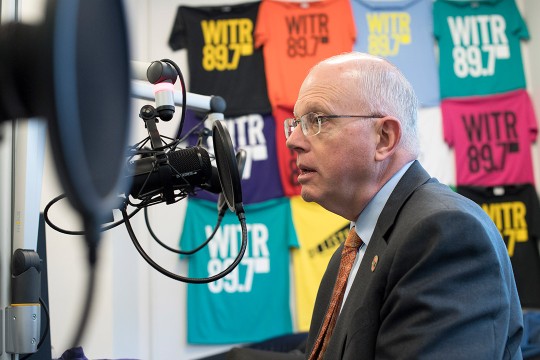Artificial intelligence aids cultural heritage researchers documenting and teaching oral histories
The application of artificial intelligence (AI) continues to expand as more people experiment with the technology. Scholars in RIT’s College of Liberal Arts, the RIT Archives, and the Research Computing services are exploring how AI can aid scholars working with oral histories.
After learning about an AI software called Whisper, Professor Tamar Carroll, chair of the Department of History, was excited about the possible applications of the tool for her own work. She utilized the AI transcription aid for her ongoing research project on Kodak’s Lambda Network and her work with the journal Rochester History. Carroll also introduced her Oral History class to AI transcription tools so her students could gain experience with the software.
“Without an AI transcription aid, it’s typical to spend a minimum of four hours transcribing just one hour of recorded audio,” said Carroll.
While Whisper AI is the most accurate transcription tool currently available, one obstacle for using it is accessing machines that can run the software.
“Whisper AI has the largest natural language processing model, but in order to run that model you need more computing power than most laptops have. RIT’s Research Computing cluster can process several hours of interviews using Whisper in less than one hour.”
The Lambda Network at Kodak
As part of the Kodak Lambda Network project, Carroll and her team collected oral histories from past members. Among these memories, members recounted their experiences from participating in the 1993 march on Washington D.C. for LGBTQ rights.
She and Benjamin Myers, research computing facilitator, discussed how cultural heritage scholars might benefit from working with the Research Computing cluster. Once her project proposal was approved and she and her research assistants were given access, Myers provided trainings on how to use the cluster to run the Whisper software.
Caitlin McCabe ’24 (museum studies and history) emerged as a student leader in teaching others how to use the computing cluster after their initial trainings with Myers. McCabe helped train Emmarose Tabin ’24 (humanities, computing, and design) on how to use the software.
Tabin, from Rochester, N.Y., became interested in oral history while working with Carroll for a summer co-op. After completing her co-op, she was hired as one of Carroll’s research assistants to continue her work on the Lambda Network project.
“Oral histories are really a way for us to capture a moment in time,” said Tabin. “You’re not just recording the facts of an event, it's a way to get a closer look at the human side of history.”
There’s something special about hearing people tell their own stories, she said.
“I think it can evoke different emotions and a different level of connection,” said Tabin.
During her co-op and assistantship, she got experience with both manual transcription and AI-assisted transcription.
“Transcribing a single interview without AI took me days. I conducted 16 interviews with Lambda members, and they ranged from two minutes up to an hour,” said Tabin. “With that volume of recordings it was very useful to clump them all together and have AI do the first pass.”
In the RIT Archives, Elizabeth (Liz) Call, Landyn Hatch ‘20 (museum studies), and their student employees have used AI to help support their oral history workflows. AI-assisted transcription allowed them to transcribe a backlog of recorded oral histories in the archives’ collections, and helps to support the RIT Archives StoryBooth Collection of oral histories.
Last spring, the pair worked with students in Carroll’s Oral History course to help test whether another oral history software called Their Story, which also uses Whisper AI, could support the archives’ needs for documenting and preserving oral histories.
“I found that AI can make it easier to teach oral history transcription to our students because they're not starting with a blank page,” said Hatch, the Marie Golisano Graham outreach archivist. “At the end of the Oral History course, one of the students told me, ‘I can’t imagine myself doing this without having had AI.’ Seeing how quickly the technology has developed even since I was a student a few years ago—and having the opportunity to learn these AI tools alongside the students—is really exciting.”
Call, RIT’s university archivist, explained that AI doesn’t replace human involvement or thinking in the transcription process. In some ways, she thinks that researchers are able to be even more vigilant and deeply critical when reviewing the oral histories because they can focus on the finer details of the content, such as documenting speech patterns and tone, in addition to focusing on accuracy.
She sees many possibilities for how AI can benefit the field of cultural heritage, such as using it to create alt text for images online to help increase accessibility.
“For our students, I think the more platforms they can test and trial, the more adept and comfortable they become with having to pivot and learn something new,” Call said. “And I think that's just a life skill that you need to have entering any field.”
To learn more about how AI can be utilized for oral history documentation, email Tamar Carroll at tamar.carroll@rit.edu. To learn more about how AI is being used in the RIT Archives, email Elizabeth (Liz) Call at elizabeth.call@rit.edu.














